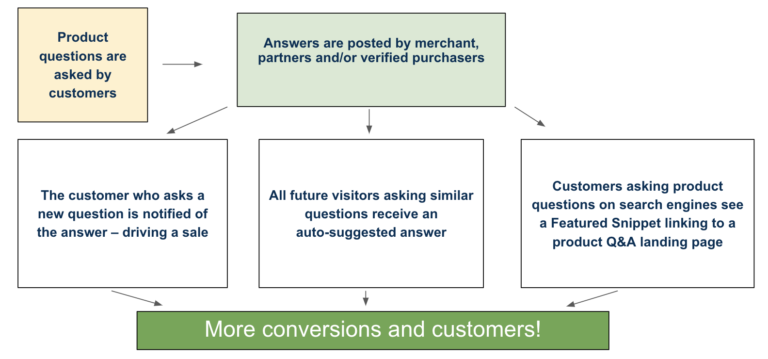Want to learn how to increase your ecommerce site’s organic traffic up and boost your conversion rates?
Using simple plugins, you can start creating high-purchase intent content that drives Page 1 search results and on-page conversions.
On March 10, I moderated a Search Engine Journal webinar presented by Duane “DJ” Sprague, CMO at Shopper Approved.
Sprague shared a semi-automated process for ecommerce sites to create product Q&A, user-generated content (UGC), and social proof that can help you stand out from the competition.
Here’s a recap of his presentation.
Everyone wants more traffic and conversions.
But with the steep level of competition in ecommerce, both don’t come easy.
Paid traffic is often expensive and has a low CTR.
Organic traffic, on the other hand, can be difficult to rank for.
Sprague’s team at Shopper Approved found a way to solve the ecommerce traffic and conversion problems automatically, allowing you to:
- Add thousands of highly relevant search results to own Google’s SERPs.
- Get up to 400% more organic traffic.
- Get nearly 75% conversion rate on product pages.
Here’s how to do it.
Make Trust the Priority On & Off the Page
We always talk about content being king. But if we think about it, the reality is that the sole purpose of content is to do one thing – create trust.
In ecommerce, trust is the king of kings. When there is no trust, we don’t have organic search rankings, conversions, and even customers.
Ecommerce brands must establish and maintain trust throughout the buyer journey.
People will do business with companies they know, like, and trust. And trust is the most important part of that equation.
Producing expert brand written content and credible user-generated content (UGC) can help you foster that trust with your customers.
UGC is among the most valuable types of content you can create for your business, because it’s the most authentic and trustworthy content “in the eyes of the consumer.”
The Consumer Content Report by Stackla found that 86% of consumers say authenticity is important when deciding what brands they like and support.
And another 60% of consumers say that user-generated content is the most authentic form of content.
This is why you want to do everything possible to set yourself up to collect, promote and distribute UGC throughout your website to drive that engagement and trust.
Amazon figured out the importance of UGC early on.
If you look at an Amazon product listing, along with the product description, you’ll see their “UGC stack” which includes:
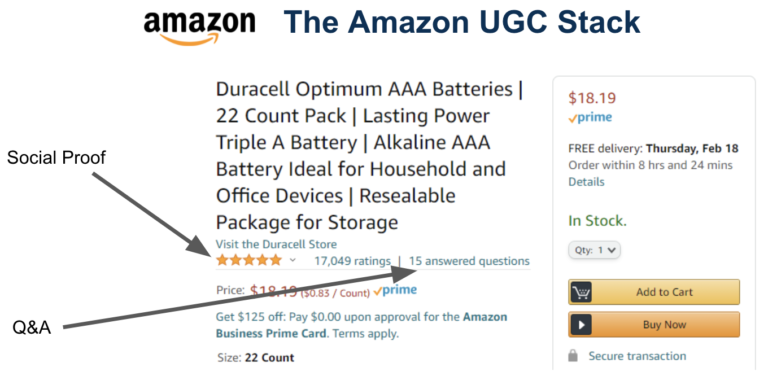
They figured out that this is the second most important content to serve right after the product description because this is what the consumer wants to see to validate the quality and efficacy of a product, to answer their questions, and resolve any concerns.
And if you look at the Customer questions and answers on Amazon, each question title links to a landing page focused on the Q&A thread.
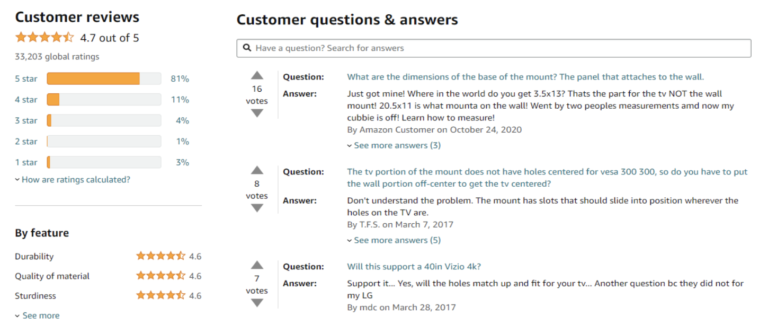
This is what helps with SEO.
Best Buy also handles it this way.
Content like this helps customers feel satisfied with their selection.
As Harvard Business Review puts it, “The marketer’s goal is to help customers feel confident about their choice.”
The easier a brand makes the purchase-decision journey – the better. This is why leveraging Q&A is a good idea to move shoppers quickly toward validation.
Your goal, therefore, is to make generating and optimizing both Q&A, ratings, and reviews a simple and automatic process to drive more traffic and conversions.
Creating a UGC stack displaying the product’s ratings, reviews and Q&A is a best practice for ecommerce websites.
Answer the Shopper’s Question Quickly & Easily With Q&A
You need to always answer the #1 question that your customers have on your product page.
When your product Q&A is optimized for search (specifically for featured snippets which get the most clicks in a SERP), it can help increase long-tail, high purchase-intent organic traffic.
Even better, if you’re using automation, with solutions like Shopper Approved, you’ll be able to generate highly relevant search results in Google at scale.
JavaScript automatically creates the highlighted text that answers the search question on the featured snippet landing page.
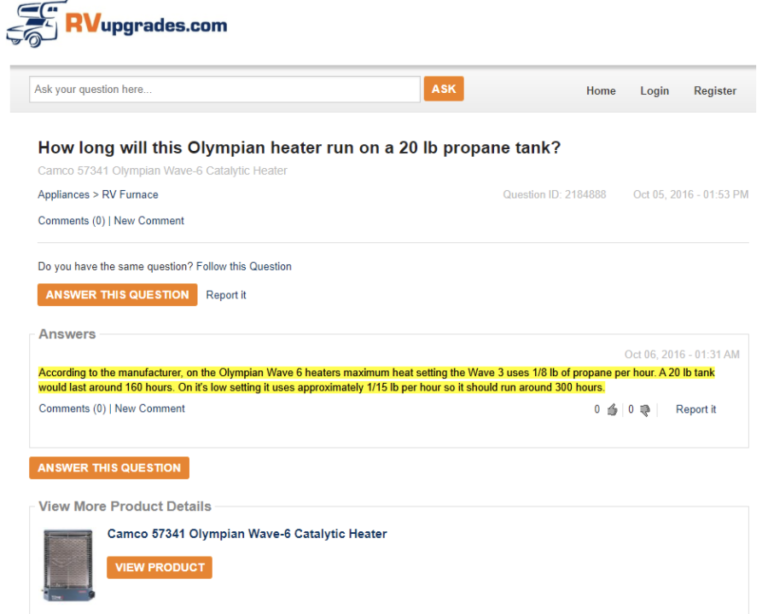
When the search question is answered like this, Sprague’s team found that shoppers convert at an average of 75% and have up to 2x average lifetime value (LTV) over regular Google organic traffic.
However, the rest of the conversion story lies in the additional social proof provided by the ratings and reviews nested with the Q&A.
Product Q&A builds trust and confidence by answering specific quantitative questions about fit, application, materials, etc.
SEO Tips for Product Q&A
These steps will help you optimize your product Q&As for search:
- Ensure Q&A text is mark up on the page so Google can identify and highlight the answer.
- Add a product call to action on the Q&A page.
- Focus your Q&A landing page efforts on optimizing for product questions. Use the product question in:
- The URL Slug (https://example.com/answers/this-is-the-question-title)
- Title Tag
- H1 Tag
- Image Attributes
- Enable community answers from verified customers and partners.
- Include structured data on Q&A landing pages.
- Use the QAPage Schema to get Q&A rich results.
Dominate Organic Search Results with Q&A, Ratings, Reviews & Review Videos
Ecommerce brands need to own their “Reviews” search results.
Having a ratings and reviews widget is important to build trust and confidence and helps answer questions about quality, service, and support in a narrative, qualitative format.
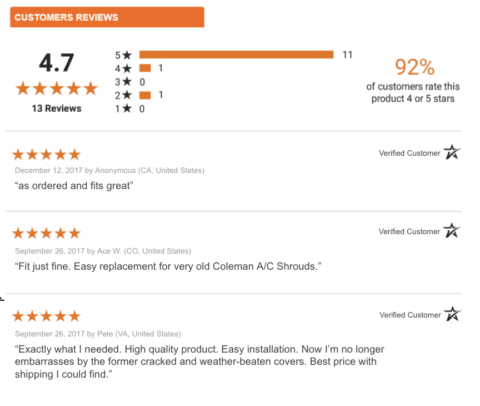
Using Shopper Approved’s Review Widget on your website can improve SEO and fuel the rating and review of rich snippets in paid and organic search.
Here’s a look at how the widget works from collecting ratings post-purchase to distributing them to survey destinations.

The Results
After implementing Shopper Approved’s process, one ecommerce site got a 400% year-over-year organic traffic growth.
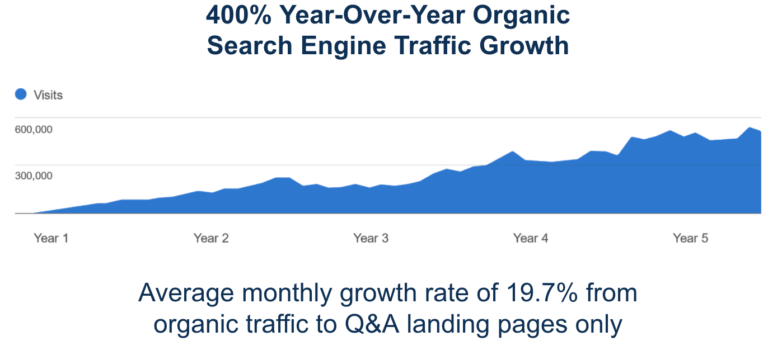
They also saw a 75% conversion rate on product pages where shoppers engaged with Q&A.
Q&A
Here are just some of the attendee questions answered by DJ Sprague.
Q: How would you approach product reviews when you are selling the same products as your competitors?
DJ Sprague (DS): I would go headfirst into collecting as many product reviews as possible, regardless of what your competitor is or is not doing.
Several studies have found that the more reviews you have, the more shoppers will prefer your product over the competitors because more reviews mean more popularity and a safer decision in the mind of the market.
Also, you can outsmart your competitors by doing a better job of promoting your reviews, and distributing them across the web using the Shopper Approved Survey Destinations tool.
Q: What kind of marketing material screams not trustworthy?
DS: Anything that is not credible or verifiable. Copy that is over the top with claims and attributes that cannot be measured or quantified is suspect. For example “the world’s leading….” is not only a worn-out platitude, but it’s often not true, and misleading.
Also, use as much user-generated content as possible, because research has shown, and Amazon has proven, that UGC is far more persuasive and credible than just about anything you can write. Consider engaging with brand ambassadors and influencers, as well, allowing them to promote your brand with their own credibility.
Q: We are planning to update our product titles and descriptions. Should we be concerned that some of these updates could drop our current Google rankings?
DS: That is always a possibility in the short-term, but if your product titles and descriptions are unique in relation to the competition, and more descriptive, accurate, and compelling, you will come out ahead.
Q: How do I compete with a big brand similar to my product?
DS: You outsmart and outmaneuver them. You can easily outrank even Amazon in organic searches when you use the right Q&A tool and strategy from Shopper Approved.
You can also do a better job of collecting and promoting your reviews and video reviews on your website and across the web, as we saw in the webinar. This will create more visibility, traffic, and conversions.
And finally, think about a unique value proposition that you can offer. For example, when Zappos started selling shoes online, they had a lot of competition. But nobody else was offering free shipping both ways.
So Zappos removed the biggest concern online shoppers had with shoes, which was the cost of shipping, and the cost of returning if they did not fit.
What they found was that with free shipping (no-risk) people ordered several pairs at a time, and kept 3-4 pairs, and returned 1 or 2. But the average order value and profits went through the roof.
[Slides] How We Increased Organic Traffic by 400% with Automation
Check out the SlideShare below.
Image Credit
Screenshots taken by author, March 2021

